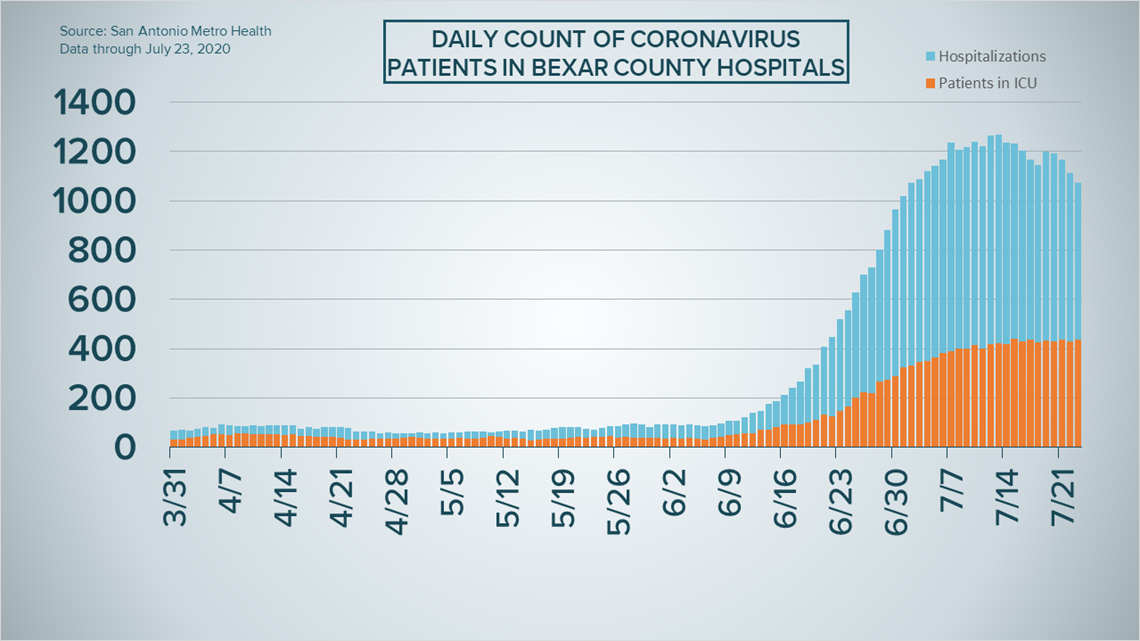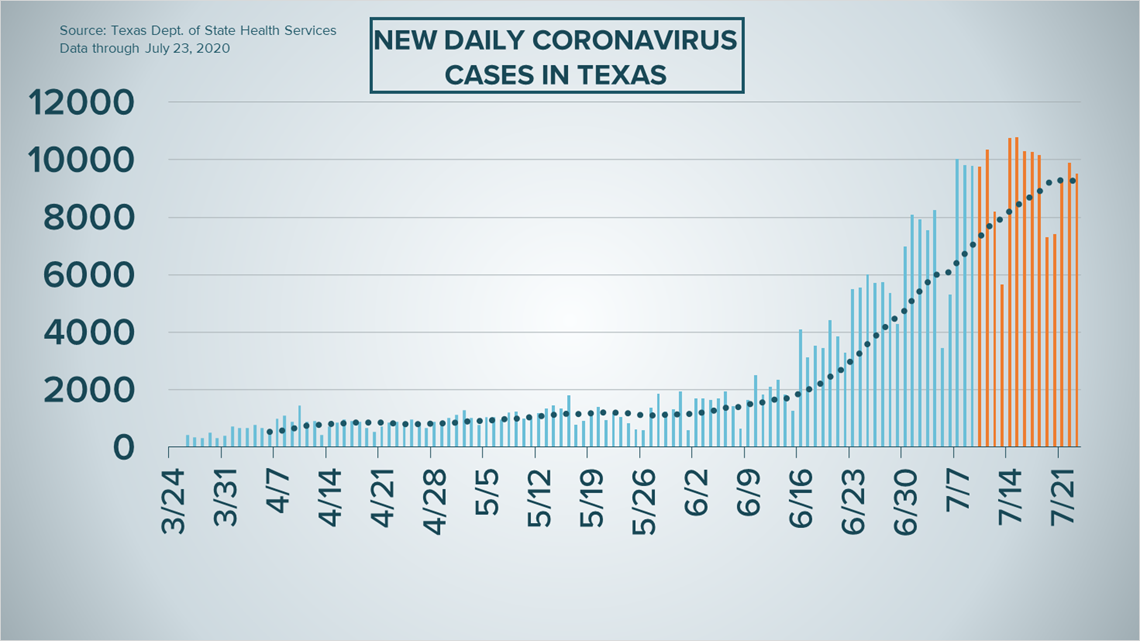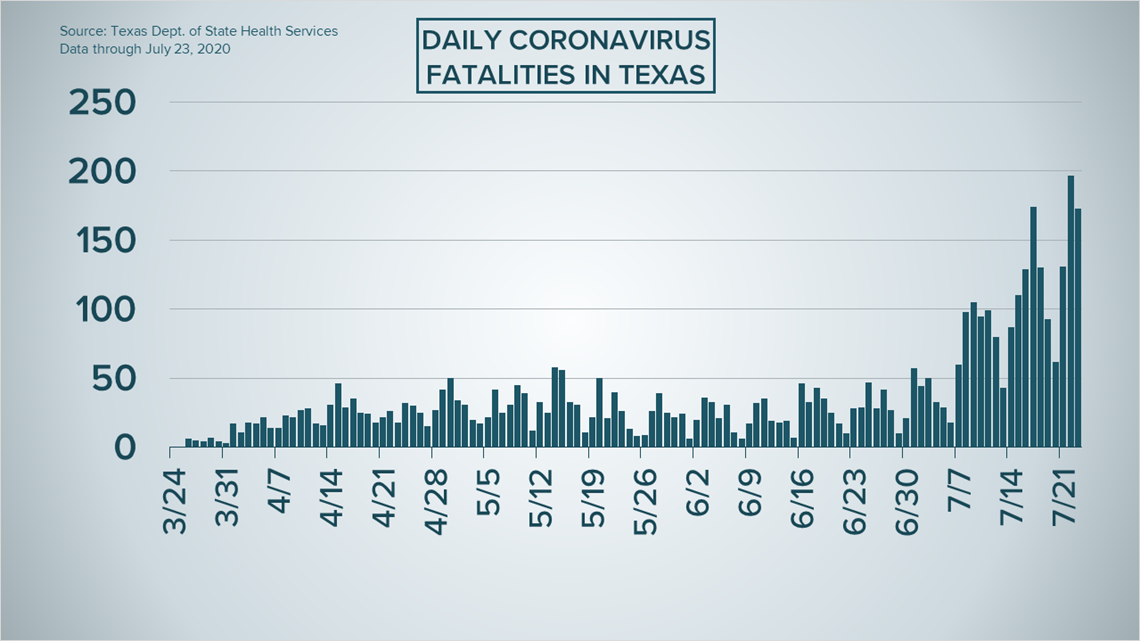SAN ANTONIO — We're tracking the latest numbers from the coronavirus pandemic in San Antonio and across Texas. Here are the latest numbers reported by Bexar and surrounding counties:
- Bexar County: 1,078 new cases and a record-high 15 additional fatalities from COVID-19 were reported Thursday. There have been a total of 34,633 cases and 298 virus-related fatalities in the county.
- Comal County: The county reported 49 new cases on Friday. Officials also confirmed the county's 44th death. There have been a total of 1,880 cases.
- Hays County: The county confirmed an additional 46 cases on Thursday, bringing the total number of cases to 4,091. 2,992 of those cases are considered active. One additional death was reported Thursday, bringing the total to 22.
How Bexar County is trending
We're tracking how many coronavirus cases are confirmed in Bexar County each day from the time San Antonio Metro Health began reporting cases more than two months ago. Graphing those daily case numbers along a 14-day moving average provides an accurate picture of the curve in the San Antonio area and the direction we're heading amid the coronavirus.
On Thursday, Mayor Ron Nirenberg reported a substantial jump in new coronavirus cases for Bexar County, with 1,078 additional diagnoses. That brings the region's total number of cases to 34,633.


A record-high 15 new deaths from coronavirus-related complications were also reported by the mayor, including victims in their 40s and 50s. In total, 298 county residents have lost their lives to the coronavirus.
For the fifth straight day, the number of concurrent COVID-19 hospitalizations dipped slightly for the county. On Thursday, Nirenberg said 1,074 were hospitalized with the coronavirus, 287 were on ventilators to assist them with breathing, and 437 were in intensive care.


Mayor Nirenberg noted that 40% of patients who have gone on ventilators in local hospitals have died.
12% of hospital beds in the county are available.
Coronavirus in Texas
State health officials on Thursday reported another large increase in new coronavirus diagnoses, with almost 9,507. There have been 361,125 confirmed COVID-19 cases in Texas during the ongoing pandemic.


Additionally, the state reported 173 new virus-related deaths, making this the third-deadliest day in Texas during the pandemic. The statewide death toll is now 4,521 as the virus continues to devastate large metro communities as well as towns near the U.S.-Mexico border.


Texas reported a lower number of patients in the hospital after a record high of 10,893 on Wednesday but explained that the numbers were incomplete.
"DSHS is reporting incomplete hospitalization numbers today due to a transition in reporting to comply with new federal requirements," the state's website said. "For July 23, 84.5 percent of hospitals reported complete data to DSHS, resulting in a partial data set and the appearance of a drop in hospitalizations. DSHS continues to work with Texas hospitals during this transition to ensure all facilities can fully report the data required."
Latest Coronavirus Headlines
- Trump says some schools may need to delay reopening in the fall
- 'Mulan' pushed back again while theaters beg studios to release blockbusters
- Freestanding emergency rooms play important role in coronavirus pandemic
- Hays County reports 2,992 active COVID-19 cases, 22 deaths
- Trump cancels Jacksonville segment of Republican National Convention
- Wurstfest cancels 2020 festival amid coronavirus pandemic
- Masked man: Spurs' Popovich wears face covering for first scrimmage
- As Congress feuds over unemployment payments, many jobless Texans are about to lose a $600 weekly benefit
- 3 in 4 Americans back requiring wearing masks, poll says
- Old Navy, Gap added to list of businesses requiring customers to wear face masks
- White House drops payroll tax cut as GOP unveils coronavirus aid
- Very few Americans back full school reopening, poll says
Coronavirus symptoms
The symptoms of coronavirus can be similar to the flu or a bad cold. Symptoms include fever or chills, cough, shortness of breath or difficulty breathing, fatigue, muscle or body aches, headache, new loss of taste or smell sore throat, congestion or runny nose, nausea or vomiting and diarrhea, according to the Centers for Disease Control.
Most healthy people will have mild symptoms. A study of more than 72,000 patients by the Centers for Disease Control in China showed 80 percent of the cases there were mild.
But infections can cause pneumonia, severe acute respiratory syndrome, kidney failure, and even death, according to the World Health Organization. Older people with underlying health conditions are most at risk.
On June 25, the CDC expanded the list of groups at a higher risk of severe illness due to coronavirus.
Experts determined there was consistent evidence these conditions increase a person's risk, regardless of age:
- Chronic kidney disease
- COPD (chronic obstructive pulmonary disease)
- Obesity (BMI of 30 or higher)
- Immunocompromised state (weakened immune system) from solid organ transplant
- Serious heart conditions, such as heart failure, coronary artery disease, or cardiomyopathies
- Sickle cell disease
- Type 2 diabetes
The CDC believes symptoms may appear anywhere from two to 14 days after being exposed.
Human coronaviruses are usually spread...
- Between people who are in close contact with one another (within about 6 feet).
- Through respiratory droplets produced when an infected person coughs, sneezes or talks. These droplets can land in the mouths or noses of people who are nearby or possibly be inhaled into the lungs.
- Some recent studies have suggested that COVID-19 may be spread by people who are not showing symptoms.
Help stop the spread of coronavirus
- Stay home when you are sick.
- Eat and sleep separately from your family members
- Use different utensils and dishes
- Cover your cough or sneeze with your arm, not your hand.
- If you use a tissue, throw it in the trash.
Lower your risk
- Wash your hands often with soap and water for at least 20 seconds. If soap and water are not available, use an alcohol-based hand sanitizer.
- Avoid touching your eyes, nose, and mouth with unwashed hands.
- Avoid close contact with people who are sick.
- Clean and disinfect frequently touched objects and surfaces.
- The CDC recommends wearing a mask or cloth face covering if you have to be out due to an essential service or essential activity such as going to the grocery store.
- If you are 60 or over and have an underlying health condition such as cardiovascular disease, diabetes or respiratory illnesses like asthma or COPD, the World Health Organization advises you to try to avoid crowds or places where you might interact with people who are sick.

